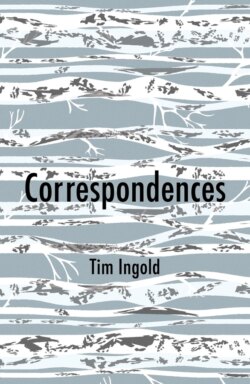Correspondences

Реклама. ООО «ЛитРес», ИНН: 7719571260.
Оглавление
Tim Ingold. Correspondences
CONTENTS
Guide
List of Illustrations
Pages
Correspondences
Preface and acknowledgements
Notes
Invitation. Letters from the heart
Digitization and loss
More than human
Being and becoming
A waste of knowing
The rigour of amateurs
The way of art
Notes
TALES FROM THE WOODS
Introduction
Somewhere in Northern Karelia …
Notes
Pitch black and firelight
Notes
In the shadow of tree being
Body
Shadow
Touch
Time
Art
Notes
Ta, Da, Ça!
Notes
SPITTING, CLIMBING, SOARING, FALLING
Introduction
Notes
The foamy saliva of a horse
The mountaineer’s lament
Notes
On flight
Notes
Sounds of snow
Notes
GOING TO GROUND
Introduction
Notes
Scissors paper stone
I
II
III
IV
Notes
Ad coelum
Notes
Are we afloat?
Notes
Shelter
Notes
Doing time
Notes
THE AGES OF THE EARTH
Introduction
Notes
The elements of fortune
Notes
A stone’s life
I
II
III
Notes
The jetty
Notes
On extinction
Notes
Three short fables of self-reinforcement
I
II
III
Notes
LINE, CREASE, THREAD
Introduction
Lines in the landscape
Notes
The chalk-line and the shadow
Fold
Notes
Taking a thread for a walk
Notes
Letter-line and strike-through
Notes
FOR THE LOVE OF WORDS
Introduction
Notes
Words to meet the world
Notes
In defence of handwriting
Notes
Diabolism and logophilia
Notes
Cold blue steel
Notes
Au revoir
POLITY END USER LICENSE AGREEMENT
Отрывок из книги
Tim Ingold
The essays assembled here all exemplify this aim in one way or another, and they range over the four fields that the KFI project sought to harness to it: of anthropology, art, architecture and design. An earlier version of the book, with just sixteen chapters (including four essays and three interviews omitted from the new version), was published ‘in house’ by the University of Aberdeen, in 2017, as one of a series of experimental volumes resulting from the project.1 Although I have carried over nine essays from the original version into the new one, several of them have been revised, and others are almost completely rewritten. The remaining eighteen essays are new material.
.....
If, today, our world is in crisis, it is because we have forgotten how to correspond. We have engaged, instead, in campaigns of interaction. Parties to interaction face each other with their identities and objectives already in place, and transact in ways that serve, but do nothing to transform, their separate interests. Their difference is given from the start, and remains afterwards. Interaction is thus a between relation. Correspondence, however, goes along. The trouble is that we have been so wrapped up in our interactions with others that we have failed to notice how both we and they go along together in the current of time. As I’ve tried to show, correspondence is about the ways along which lives, in their perpetual unfolding or becoming, simultaneously join together and differentiate themselves, one from another. This shift from interaction to correspondence entails a fundamental reorientation, from the between-ness of beings and things to their in-between-ness.3 Think of a river and its banks. We might speak of the relation of one bank to the other and, crossing a bridge, we might find ourselves halfway between the two. But the banks are perpetually forming and re-forming as the river waters sweep by. These waters flow in-between the banks, in a direction orthogonal to the span of the bridge. To say of beings and things that they are in-between is to align our awareness with the waters; to correspond with them is to join this awareness with the flow. Just such a shift of orientation is needed, I believe, if we are to understand the world as one that we can inhabit both now and for the foreseeable future. It is, in short, a condition for sustainable living.
It is not beyond our grasp, however, to imagine an alternative world, in which the machines have been replaced with people. These people might still speak of ‘data’, but they would intend the term to be taken literally, as that which is given to them, so that they might live and know. They accept, with good grace, what the world offers to them, rather than attempting to extract – whether by force or subterfuge – what it does not. They are nourished by this offering, just as they are by the food they eat, and, as with food, they go on to digest it. But for them digestion is, above all, a process of life and growth. In producing knowledge, then, they are also producing their own selves as people who know. They are of course aware that any such process entails a degree of friction: not everything can be incorporated into growth and some things pass through undigested. There is surely no craft that does not, in the fashioning of its materials, generate copious quantities of waste, whether in the form of dust, shavings, chips or off-cuts. It is no different with the crafts of the intellect. But in this alternative world, waste is not knowledge. It only becomes knowledge when it is re-entered into a process of life.
.....